Haworthia spp.
Haworthias (Haworthia spp.) are fleshy-leaved succulents that require little water or maintenance to thrive.
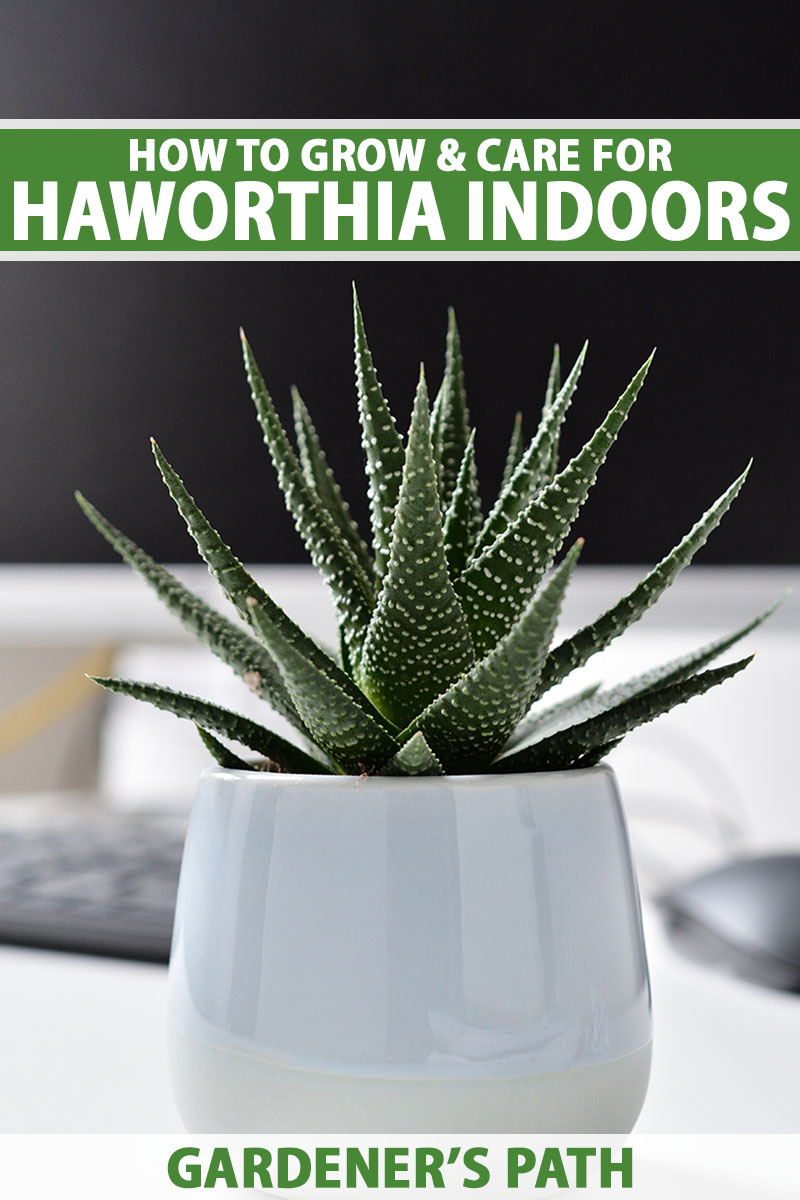
We link to vendors to help you find relevant products. If you buy from one of our links, we may earn a commission.
Native to southern regions of Africa, they thrive outdoors in USDA Hardiness Zones 9 to 11 and make excellent houseplants in all locations.
Our guide to growing succulents in the garden has all you need to know to establish and care for a variety of succulents outdoors.
This guide discusses how to grow haworthias indoors.
Here’s a preview of what’s in store:
What You’ll Learn
Get ready to meet haworthias!
What Are Haworthias?
Haworthia is a broad and evolving succulent genus with about 60 species to date.
The genus was previously divided into three subgenera, differentiated by the shape of the base of their flowers:
- Haworthia, with triangular bases
- Hexangulares, with hexagonal bases
- Robustipedunculatae, with rounded bases
In 2013, botanists started to reclassify these subgenera, based on DNA analysis. Species in the subgenus Hexangulares are now classified as Haworthiopsis, and Robustipedunculatae are now part of the Tulista genus.
Species currently classified in the Hawthoria genus are those that were formerly part of the subgenus of the same name.
In spite of the reclassification, many growers still refer to many of the species in the Haworthiopsis and Tulista genera as “hawthoria.”
There are about 150 named haworthia varieties, making collecting them great fun.
Most feature stemless rosettes, although there are stemmed ones as well. Textures range from translucent, smooth, and striped to opaque, ridged, and rough. Most are green, or green with white accents.
The growing season for haworthias varies by the species and the climate conditions of their native habitats. For many, summer and fall are dormant periods.
Plants may produce a bare flower stalk or “raceme” topped with star-shaped, usually white blossoms. Typical bloom time is in the spring, although, again, this may vary.
It’s easy to start and grow plants. Let’s find out how.
Propagation
There are several ways to begin:
- Seeds
- Coring
- Cuttings
- Root Separation
- Transplant Nursery Pots
Let’s look at each.
From Seed
If you have a plant, you can try to collect the tiny seeds from the pods that form after the flowers bloom. These plants aren’t self-pollinating, so you will need to hand-pollinate the flowers. To do this, you’ll need two plants that are flowering at the same time.
The process involves removing an anther from one plant and transferring the pollen to the stigma of a second plant.
When the pods are still green, some growers like to wrap clear tape around them, leaving the top open, to catch the seeds when they dry and drop.
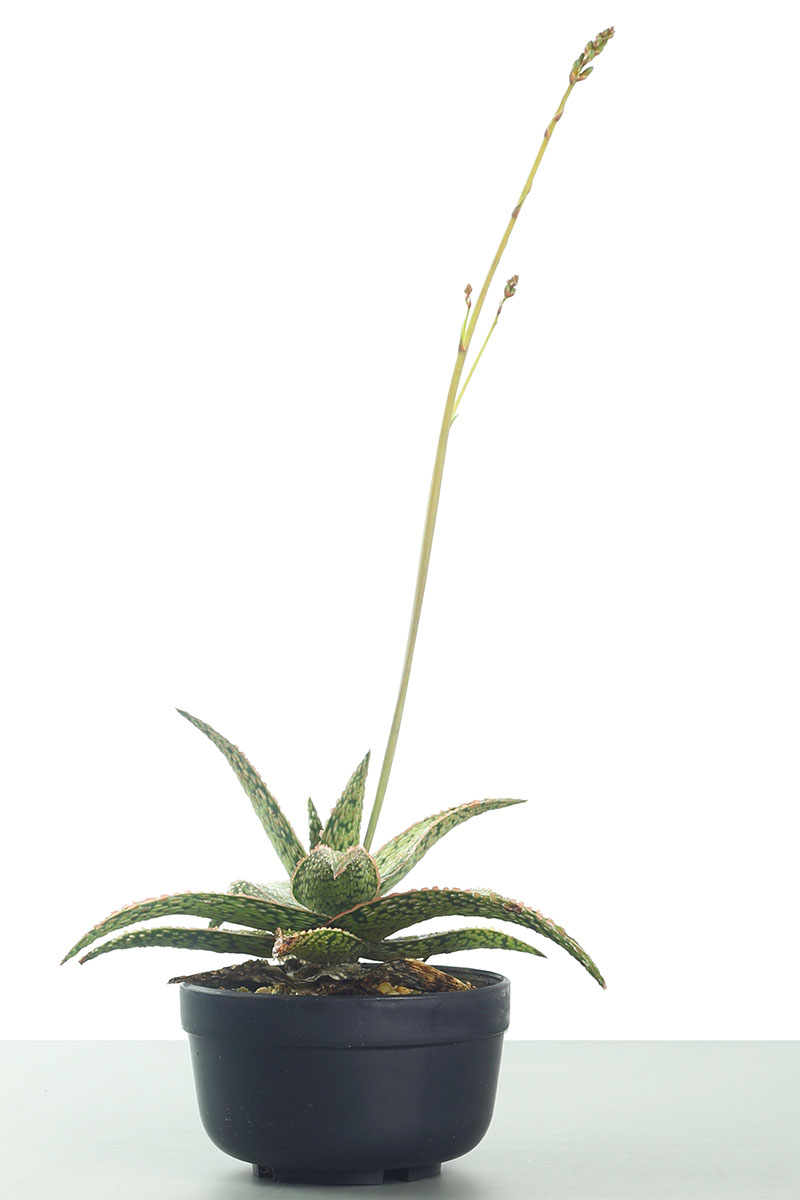
Alternatively, watch for the pods to dry and gently rub them to release the seeds. Catch them in a paper cup, or other suitable container.
After harvesting, some gardeners rinse the seeds with diluted peroxide or bleach as a preventative fungicide. Once they are dry, you can store the seeds in an envelope or glass jar until you are ready to sow.
Growers report that letting freshly harvested seeds “rest” for a minimum of two months or up to six months seems to result in the best germination rates.
Use a well-draining succulent potting soil for seed sowing. Some gardeners prefer to use sterile seed-starting soil or sterilize the soil themselves in the microwave or oven before sowing.
Fill a well-draining shallow container with two to three inches of potting soil.
Moisten the soil lightly.
Sprinkle a seed or two every three inches.
Barely cover the seed with a thin layer of perlite, succulent potting soil, or horticultural sand.
Place the container inside a zippered plastic bag and zip it closed.
Place the bagged container in bright indirect sunlight and leave the bag closed. Be careful – direct sunlight can overheat the bag and result in a failure to germinate.
The “mini-greenhouse” is self-watering and will need no supplemental moisture.
Keep an eye on it, as mold can develop if conditions are too wet. If the condensation completely clouds the bag, unzip it a little to allow some moisture to evaporate before closing it again.
Expect the seeds to germinate in one to two weeks.
In approximately four to six weeks, when the seedlings begin to crowd one another, you can transplant them to individual containers as desired.
By Coring
Coring is a method of using an existing rosette to make another. It requires the careful removal of the top half of the rosette.
Some folks use fishing line to do this, tightening it around both index fingers like dental floss and pulling it across the base.
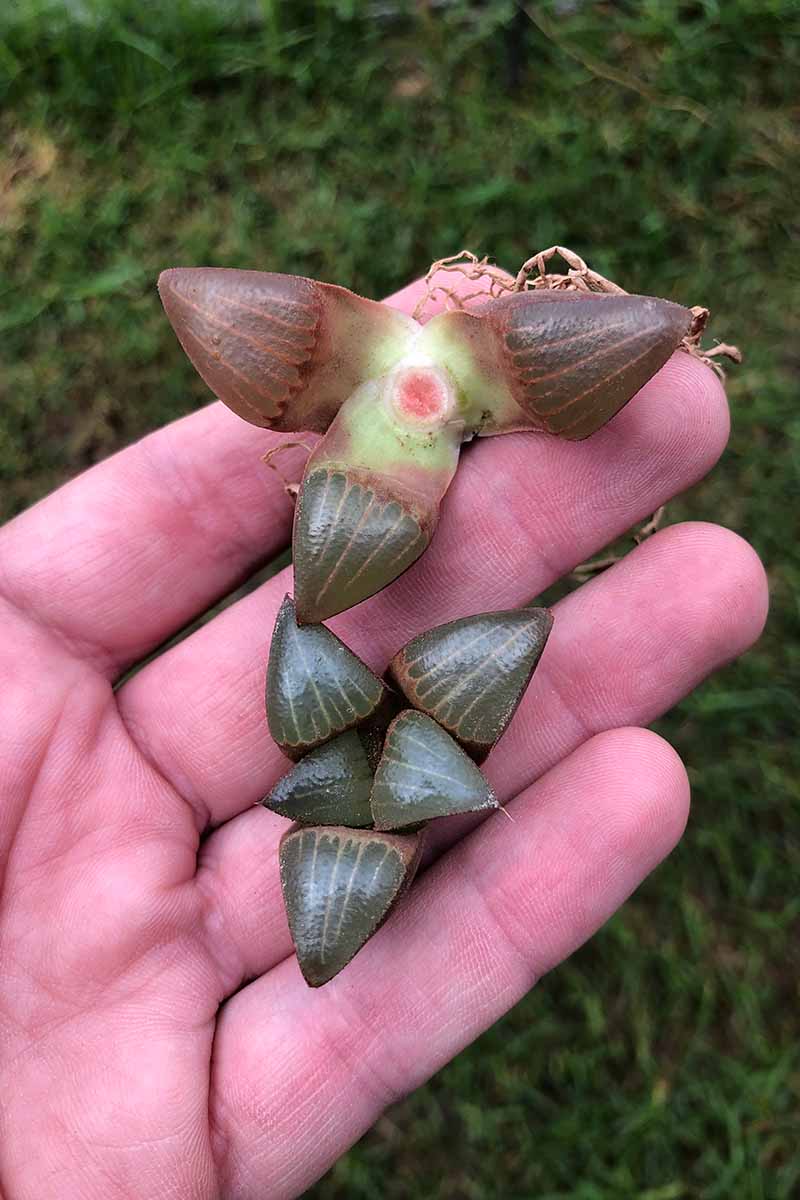
Set the rosette aside in a dry location, out of direct sunlight. In a few days, the cut core in the base dries up and forms a hard callus.
Once the callus appears, it’s only a matter of weeks before offsets begin to grow out of it.
When the top half of the rosette which you’ve removed forms a callus on its base, it is ready for transplanting. Some growers recommend anchoring it with wire to keep the new roots from pushing the plant out of the soil.
They also suggest withholding water for a month to avoid rotting, which is sound advice. However, if you notice wilting, water sparingly around the edges of the pot and avoid wetting the foliage.
The best time to core is in the spring, a time of vigorous growth.
From Cuttings
You can also begin new plants from leaf cuttings. You’ll find complete instructions for starting succulents from leaf cuttings in our guide.
Be forewarned that unlike the leaves of echeveria that pinch off easily, haworthia foliage is more challenging to separate without nicking neighboring foliage.
By Root Separation
And finally, you can separate a “mother” from the offsets that sprout beside it and replant the offsets individually.
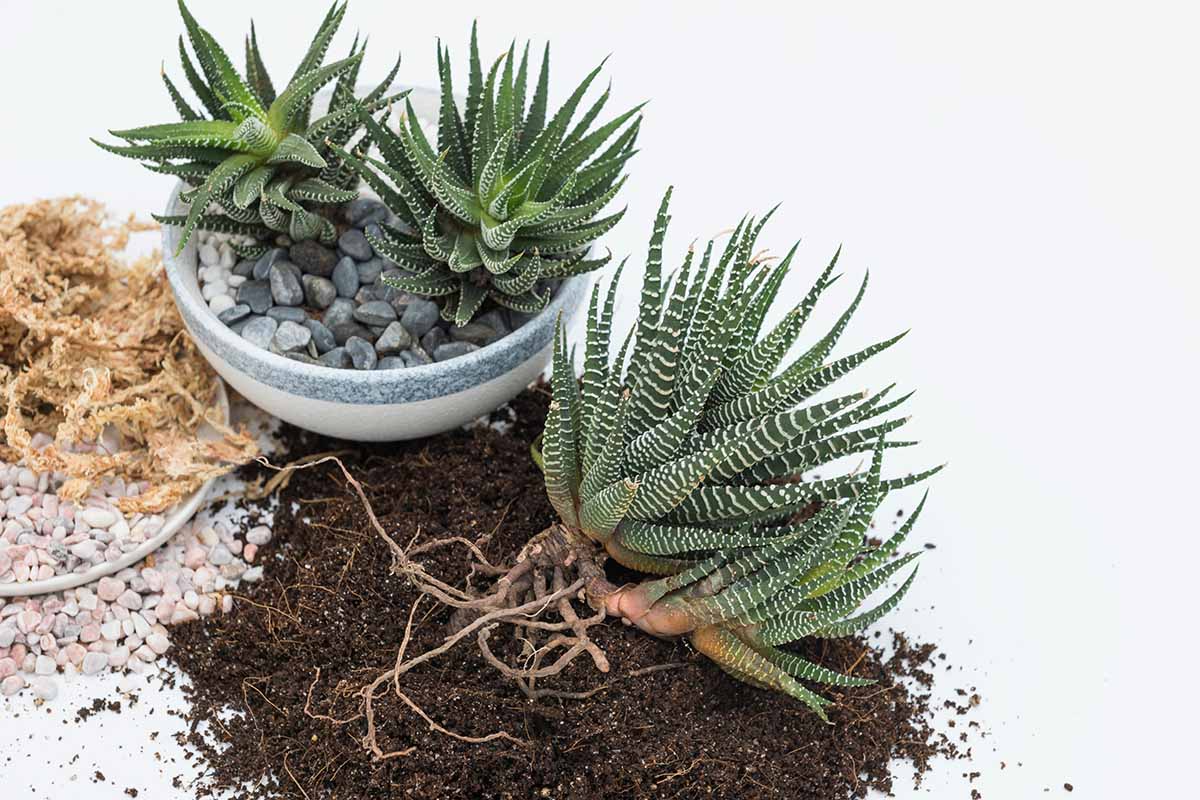
Wait to separate offsets until they have multiple leaves and their own roots. It’s better to let them get quite large than to risk separating them when they are too immature to survive independently.
To separate offsets, unearth the contents of the pot.
Use sharp pruners or garden scissors to make a clean cut with no ragged edges through the roots that attach the offsets to the mother.
Handle the roots with care, as the more of them that remain attached to the offset, the quicker it will take to its new location.
Unlike soft tissue cuttings that need to callus off first, you can transplant root-separated offsets immediately.
Transplant Nursery Pots
By far, the easiest way to begin is with a nursery-raised plant. When transplanting it to the container of your choice, the key to success is to maintain the same depth as in the original pot.
New containers should have excellent drainage, and the size you choose will depend on the mature dimensions of your chosen variety. Fill the container with succulent potting soil, leaving a little space at the rim for watering, and moisten the medium lightly.
When in doubt about transplanting depth, remember that a succulent should always sit perched on a slight mound of soil so that the foliage is even or slightly above the pot’s rim. Setting it too deeply may result in rotting.
How to Grow
In the wild, haworthias thrive in arid regions with bright, indirect sunlight or partial shade cast by rocks or larger flora.
Indoors, they do best in temperatures between 75 and 90°F. While tolerant of low-light placements, they are more likely to produce optimal color and blossoms in bright indirect light.
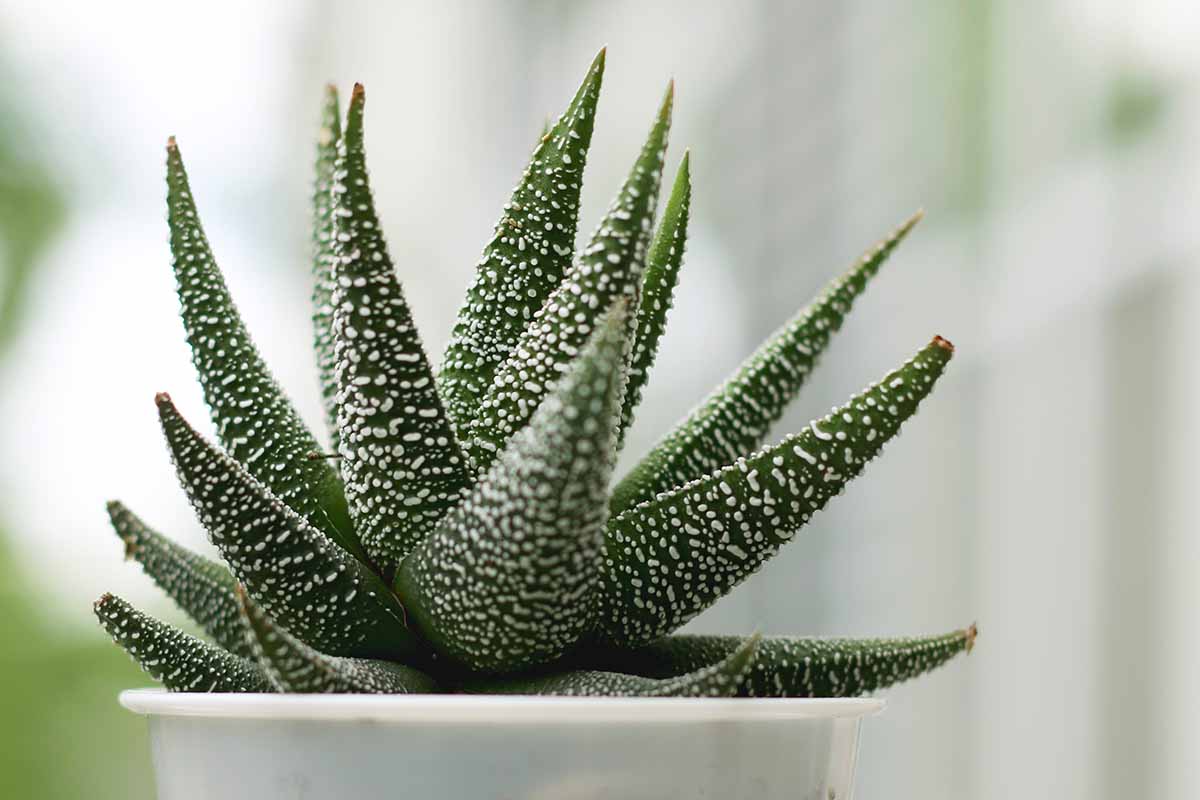
Avoid placing succulents on south-facing windowsills, especially in the summertime, as the foliage may shade to purple or red as a stress response and/or scorch.
You can use a grow light for cultivation. Place the pot at least 24 inches from the bulb if you want to avoid purple discoloration.
Use a container with drainage holes and a good quality cactus and succulent potting soil that is moisture retentive and well-draining.
The size of the container you choose will vary depending upon the dimensions of the species you choose, whether you’ll leave offsets in place, and personal aesthetics. It need not be deep, as succulent roots are shallow.
Heights range from three to 20 inches, widths from one and a half to 12 inches, depending on the species, and they may be stemmed or unstemmed. When in bloom, the racemes add height.
For example, the zebra species Haworthiopsis attenuata is four to six inches wide and six to eight inches tall. A blooming raceme adds another eight inches of height.
Watering carefully is essential with succulents. When the pot completely dries out, thoroughly soak the soil. Aim the nozzle at the soil instead of the foliage. Let any excess water drain completely before returning it to its saucer.
During dormancy, usually in summer and fall, you’ll find that you only need to water about once a month. You may want to invest in a moisture meter to guide you.
Feed plants over the age of one year once a month during the growing season. Use a liquid houseplant food intended for succulents diluted to 50 percent.
Growing Tips
Like many succulents, haworthias are easy to cultivate and require little attention. To give them a healthy start:
- Choose a temperate placement with bright indirect sunlight.
- Use well-draining, moisture-retentive succulent potting soil.
- Select a shallow, well-draining pot to accommodate mature dimensions and offsets as desired.
- Water deeply when the pot dries out completely.
- Fertilize mature succulents monthly during the growing season and withhold food during dormancy.
While easy to care for, there are a few maintenance tasks to discuss.
Maintenance
The main task is to monitor water needs.
Prolonged dehydration may lead to foliar desiccation, browning, and death.
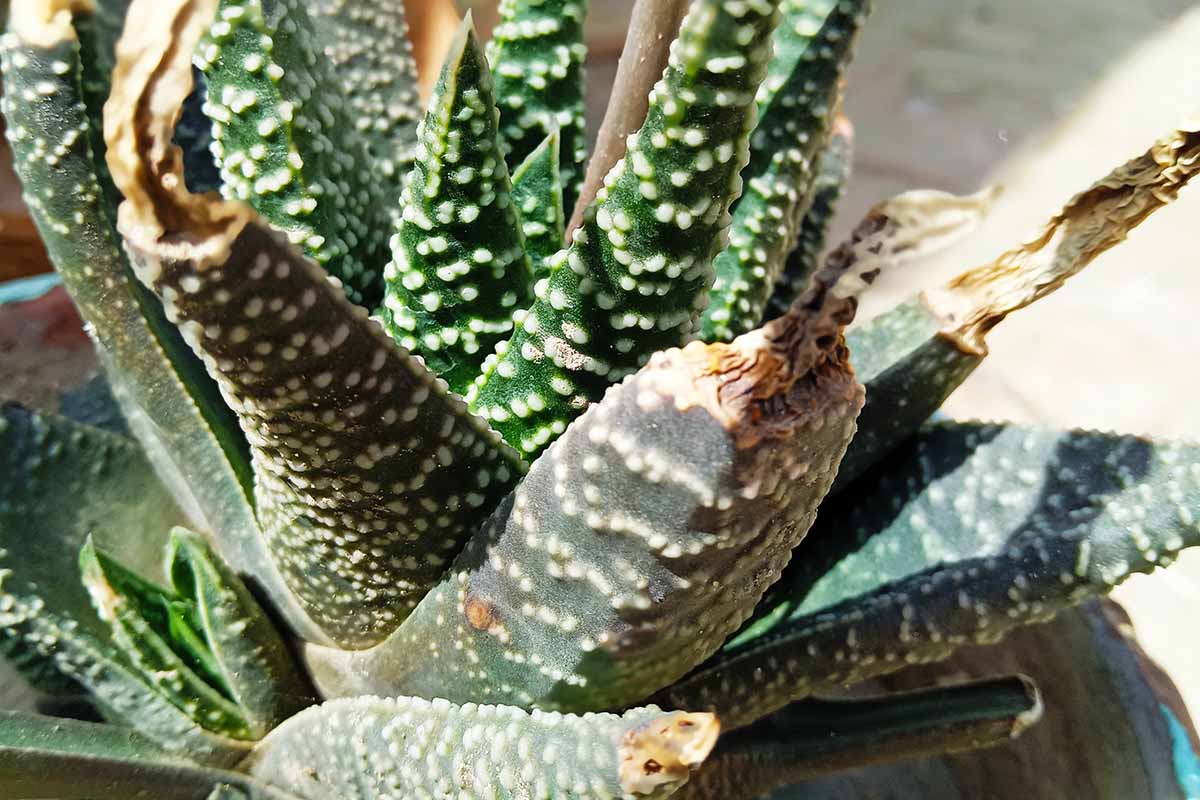
If you underwater, a little wilting isn’t usually a problem, provided you soak the soil deeply once you detect the moisture stress.
Overwatering is likely to lead to rotting. Yellowing foliage is an indication of oversaturation.
The foliage may exhibit other signs of distress. Purple or red may be the result of exposure to direct sunlight or proximity to a grow light.
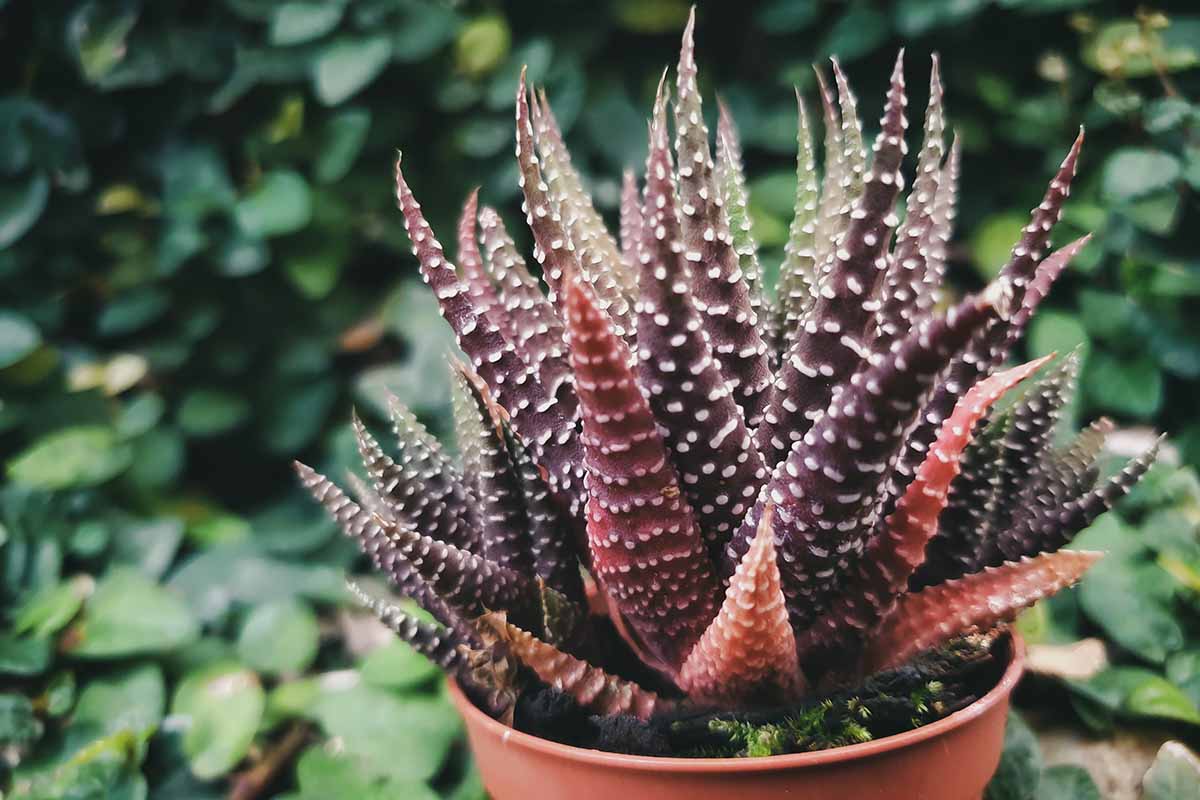
And finally, you may want to repot every three years or so. Whether your plant has outgrown its current container or not, it’s good to refresh depleted soil periodically.
Now let’s look at some unique species!
Species to Select
The following species are samples of what the Haworthia genus has to offer to the indoor succulent gardener:
Cathedral Window
H. cymbiformis, commonly known as cathedral window haworthia, star window, or window, has smooth-leaved rosettes.

The striping and translucent characteristics of the rounded leaf tips are examples of “epidermal windows” that facilitate light absorption for photosynthesis.
Cathedral window plants are available via Amazon in two-inch pots.
Mature dimensions are approximately three inches tall and four inches wide.
Fairy Washboard
Fairy washboard haworthia, H. limifolia, has flattened rosettes of ridged, pointed leaves.

Rosettes grow to approximately four inches tall and five inches wide.
Fairy washboard plants are available from Hirt’s Gardens via Amazon in two-and-a-half-inch pots.
Spider-Nest
H. arachnoidea is known as spider-nest haworthia for its rounded mound of soft, translucent bristles. You may also find it listed as cobweb aloe or paper rose haworthia.

A unique survival feature is the contraction of the foliage to conserve water in times of extreme heat and drought that causes the rosette to close up into a ball.
Its mature height is about two inches. Rosettes may spread from five to seven inches across.
Zebra
The zebra plant, Haworthiopsis attenuata, was classified as Haworthia until 2019.
Now it is Haworthiopsis, a separate genus for flora like Haworthia that have a thicker epidermis or outer leaf covering. But you’ll often still see these referred to as haworthias today nonetheless.
Although there are many other fascinating species, zebra may be the one most people associate with the word haworthia.
The features of this species include upright rosettes with white “tubercules” that allow for plant expansion and contraction during wet and dry periods.

Dimensions at maturity are about four to six inches wide and six to eight inches tall.
Zebra plants are available via Amazon in two- and four- inch starter pots and two- and four-inch clay pots.
Zebra Wart
Haworthiopsis reinwardtii, formerly Haworthia reinwardtii, resembles the zebra species, but the rosettes multiply upward in a telescoping fashion.

Mature specimens may grow up to eight inches tall.
Zebra wart plants are available from California Tropicals via Amazon in four-inch pots.
Managing Pests and Disease
Haworthia houseplants are not typically prone to pest infestations. However, some to watch out for are:
- Aloe Mite
- Fungus Gnat
- Mealybug
The aloe mite, Aceria aloinis, produces unsightly galls called aloe cancer that cause debilitating changes to plant structure and functioning.
You might notice that the leaves are deformed or develop yellowish-brown “scarring” on the edges. The pests themselves are tiny and only visible under a microscope.
The condition is challenging to manage, but miticides may prove effective.
Read our guides for more information on fungus gnats and mealybugs.
In addition to pests, the primary disease concern is root rot.
Soil oversaturation causes roots to become waterlogged and unable to take up nutrients. The wet soil provides an ideal breeding ground for fungal pathogens that feed on the roots, making them shriveled and mushy.
Unchecked, rotting works its way above the soil and into the foliage.
The best ways to avoid rotting are:
- Use a well-draining pot.
- Water only when the soil is completely dry.
- Use a moisture meter as a guide.
- Do not let water pond in a saucer below the pot.
Rotting is the most likely reason for a succulent to fail to thrive.
Best Uses
Haworthia specimens are good companions for other succulents, like aloe, jade, echeveria, sempervivum, and string of pearls. They have similar cultural requirements, and their textural variations make for an exciting display.
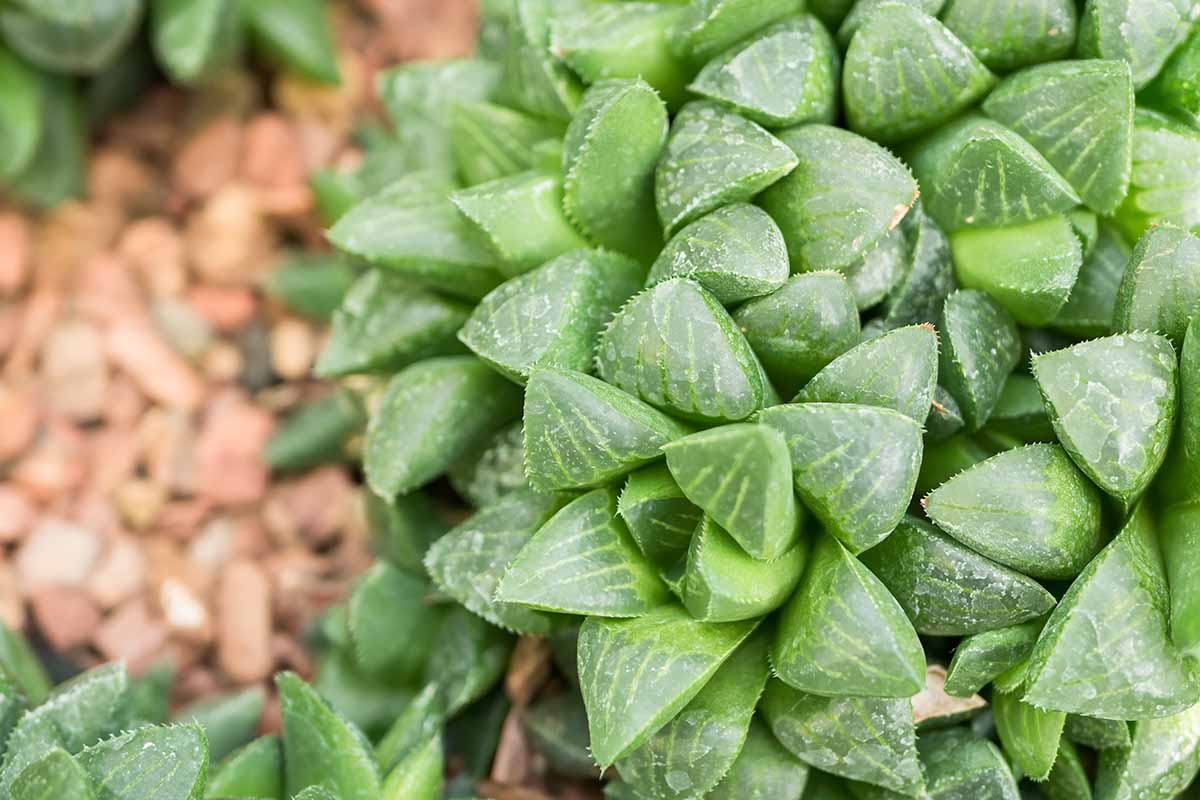
You may find suitable placements for pots near east- or west-facing windows where the light is bright but indirect.
And with its tolerance for low light, a spot on your work desk or bookshelf may also work. However, the color may not be optimal in these locations and plants may never produce blooms.
If you live in Zones 9 to 11, consider xeriscaping with haworthias. They make an excellent ground cover that is both decorative and water-wise.
Quick Reference Growing Guide
| Plant Type: | Flowering succulents | Flower / Foliage Color: | White/green with translucent or white markings |
| Native to: | Southern Africa | Maintenance | Low |
| Hardiness (USDA Zone): | 9-11 | Tolerance: | Dry soil, low light |
| Bloom Time: | Spring | Soil Type: | Cactus and succulent potting soil |
| Exposure: | Direct to bright indirect light | Soil pH: | 5.5-6.0 |
| Spacing: | 1.5-12 inches, depending on species | Soil Drainage: | Well-draining |
| Planting Depth: | Barely cover (seeds), crown above soil line (transplants) | Uses: | Indoor potted succulent collection, stand-alone specimen; outdoor xeriscaping ground cover |
| Height: | 3-20 inches, depending on species | Order: | Asparagales |
| Spread: | 1.5-12 inches, depending on species | Family: | Asphodelaceae |
| Water Needs: | Low | Subfamily: | Asphodeloideae |
| Growth Rate: | Slow | Genus: | Haworthia, Haworthiopsis, Tulista |
| Common Pests and Diseases: | Aloe mites, fungus gnats, mealybugs; root rot | Species: | Arachnoidea, attenuata, cymbiformis, fasciata, limifolia, reinwardtii |
Get Happy with Haworthias
I think you’ll agree that haworthias have much to offer:
- Easy Care
- Low Water Needs
- Size Variety
- Striking Shapes and Textures
Whether you display stand-alone specimens or include them in mixed succulent collections, your new favorites are sure to be eye-catching conversation starters.
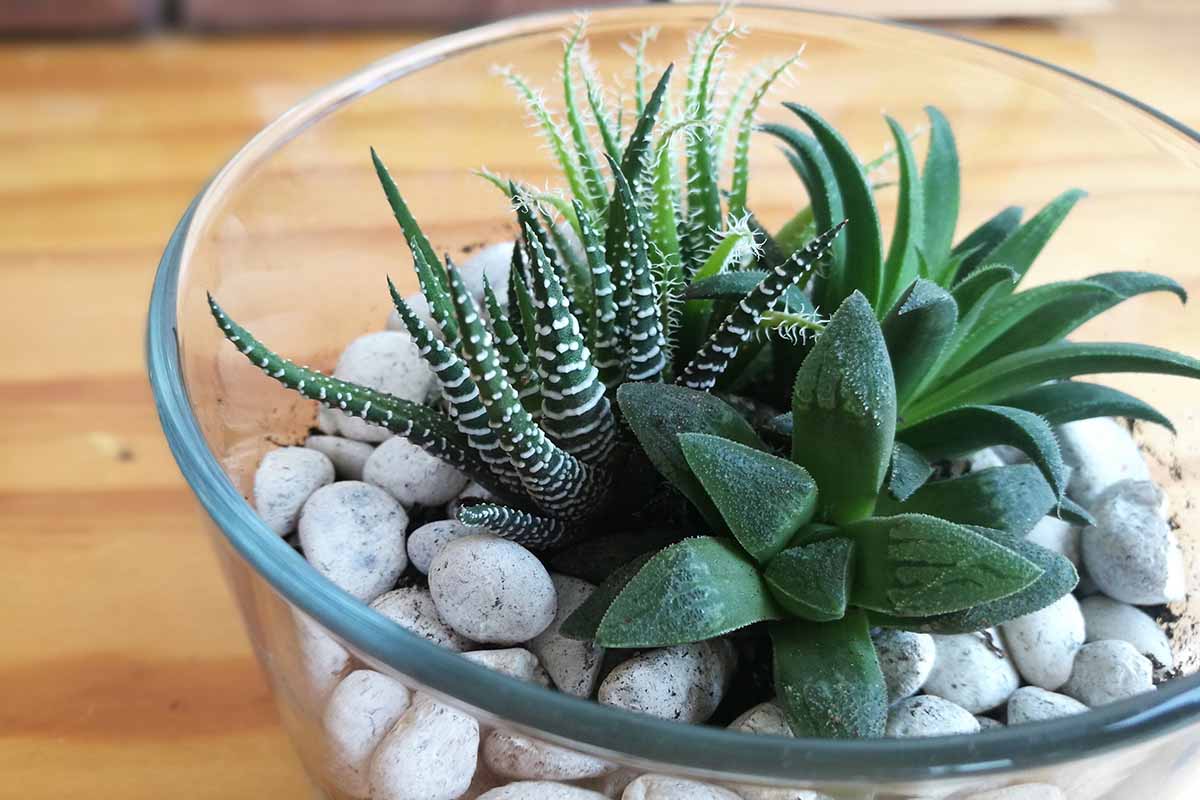
Did you know that gardening, even with small-scale potted flora, can help to ease stress and elevate the mood?
Find your bliss with indoor succulent gardening that features haworthias!
Enthusiasts may enjoy visiting the Haworthia Society webpage. Members dedicate themselves to the conservation, propagation, and study of haworthias and other South African succulents.
What variety are you growing? Let us know in the comments below, and feel free to share your photos!
If you found this guide informative and would like to learn about more succulent gardening, we recommend reading the following next:
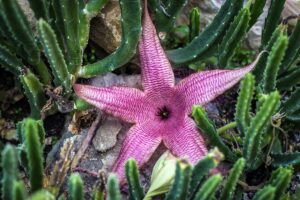
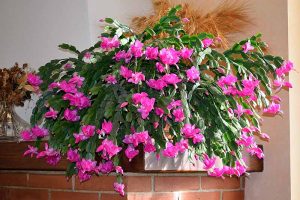
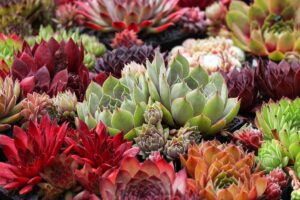
So much wonderful information . Thanks so much.